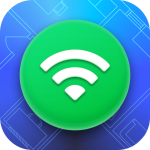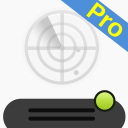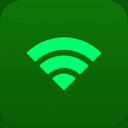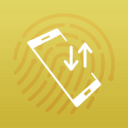Available for iPhone and iPad. Requires iOS 15.5 or later.
Best WiFi Analyzer for iPhone in 2025
Gain insights into your network's strength and performance with our WiFi analyzer for iPhone.
WiFi analyzer may sound like some geeky device used by hackers in hoodies to penetrate WiFi networks and steal private information from unsuspecting users. In reality, a WiFi analyzer is an incredibly useful software tool that all WiFi users should learn how to use.
What Is an iPhone Wi-Fi Analyzer?
You may not realize it, but you already have a basic WiFi analyzer on your iPhone, and you’ve used it at least once. Don’t believe us? Just launch Settings from your Home screen, tap the Wi-Fi option, and look at the “Choose a network” section.
It should list all WiFi networks available in your area and display basic information about them, such as their names, security, and signal strength — enough to help you connect to the right network. But what if you need more information to analyze radio signal leakages, discover noise sources, map channel usage, locate effective access points, and so on?
In that case, you need a dedicated iOS WiFi channel analyzer. The good news is that there are many different WiFi analyzer iOS apps to choose from, some more feature-packed and easier to use than others, but all intended to accomplish the same goal: give you more information about available WiFi networks.
How to Use Wi-Fi Analyzer?
WiFi analyzer iOS apps can be used for two different but complementary purposes: to determine the speed of your network and to evaluate your network's coverage.
Testing the speed of your network with the best WiFi analyzer app for iOS can be as simple as tapping a button. The app will then measure your download and upload speed, as well as your latency (also known as ping), and display everything in an easy-to-understand manner. Equipped with this information, you can determine if you're getting the speeds you should be getting from your internet service provider and your router.
Leading iPhone WiFi analyzers can also uncover all areas of signal weakness, also known as dead spots, by measuring the coverage of your network. This is typically done by taking multiple measurements in different parts of the area you want to scan, and then letting the WiFi analyzer iOS app turn the gathered data into a detailed heatmap.
Sounds useful? The next chapter of this article lists the top 10 best WiFi analyzer apps for iPhone that you can download right now.
Looking for the best app to use with your laptop? We've put together our lists of the best WiFi analyzer apps for Mac and the best WiFi analyzer apps for Windows.
Top 10 Best WiFi Analyzer Apps for iPhone
We scoured the App Store, looking for the best WiFi analyzer app for iPhone and discovered many interesting options and one clear winner. Our selection criteria were fairly straightforward: the best WiFi analyzer iOS must be easy to use, deliver accurate results, and have enough features to satisfy the needs of everyone from home users to professionals.
- NetSpot For iPhone — is the best WiFi analyzer app on the Apple App Store.
- Ubiquiti WiFiMan — is an easy-to-use app with plenty of useful features to help you keep your network running smoothly.
- iNetTools Pro — is an comprehensive collection of essential network diagnostics tools aimed at advanced users.
- Network Analyzer by Technet — can help you diagnose problems with your WiFi network and gather diagnostic information for a variety of different purposes.
- Fing — designed to be used together with Fingbox, a plug-and-play network security and parental control device.
- OpenSignal Internet Speed test — WiFi analyzer for iPhone and iPod touch that can test the speed of your WiFi and mobile connection alike.
- Scany — presents itself as the Swiss army knife of network scanning.
- Speedtest by Ookla — capable internet speed testing app that can tell you how fast your internet connection is under real-world conditions.
- Wi-Fi SweetSpots — is more than just an internet speed test utility.
- WiFi Analyzer by Master App Solution — this capable WiFi network analyzer can perform a detailed analysis of your home network and give you insight into its performance and configuration.
NetSpot for iPhone is the best WiFi analyzer app for iPhone because it offers a comprehensive suite of tools for WiFi analysis and optimization, combining a WiFi heatmapper with a speed test and ping tool into one seamless experience that's available to all iOS users.

The unique heatmap visualizations provide an intuitive and highly visual means of identifying areas with strong or weak WiFi signals. This feature is particularly beneficial for optimizing network coverage and performance in various environments, from small apartments to large office spaces.
On the other hand, the app's WiFi speed test function is a valuable tool for regularly monitoring and tracking the performance of wireless networks. It automatically connects to the nearest server and tests your download and upload speeds. You can change your location run a new test and see how the change affects your WiFi performance.
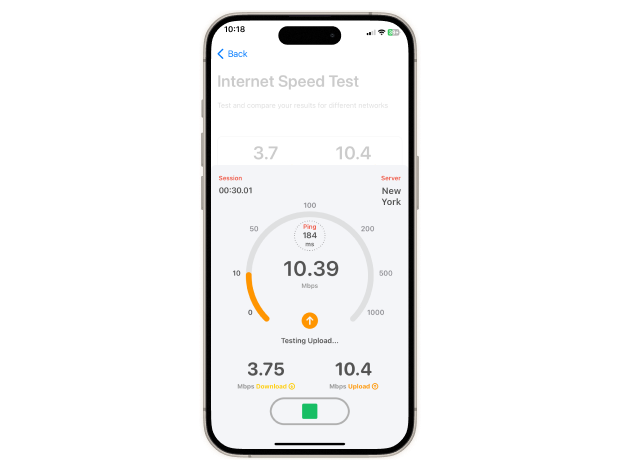
Use a separate ping test tab to check your network latency for gaming and other broadband-greedy activities.

Previously, NetSpot required an additional hardware device, the WiPry 2500x, to work, but that's no longer the case. The latest version works without it, making it more accessible and user-friendly than ever before.
- Summary recommendation:
- Download →
-
Integrates WiFi heatmapper and speed test functionalities
-
Detailed color-coded heatmaps
-
Flexible survey management
-
Doesn't require any additional hardware
-
Can analyze only the current WiFi due to iOS limitations
Developed by Ubiquiti, WiFiMan is a WiFi analyzer for iPad, iPhone, iPod touch, and Macs with Apple Silicon. Even though the app is developed by Ubiquiti, a manufacturer of wireless data communication and wired products for enterprises and homes, you don’t actually need a Ubiquiti router to use it.
WiFiMan WiFi analyzer for iOS is split into three main tabs. The first tab is dedicated to testing your internet speed, the second tab is where you can find detailed information about your WiFi network, and the third tab lets you discover devices connected to your network and learn useful information about them.
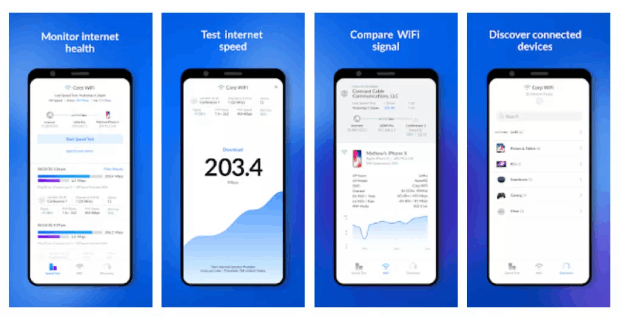
Unfortunately, the signal strength analyzer portion of this app is available only to the users of Ubiquiti UniFi products. If you're not among them, then you should go with NetSpot instead since it's the best brand-agnostic WiFi analyzer app for iOS.
-
Thorough overview of your network's performance
-
Integrates seamlessly with Ubiquiti products
-
Modern and clean user interface
-
Completely free
-
Signal strength mapping available only to Ubiquiti users
iNetTools Pro is a handy toolbox that’s packed to the brim with network diagnostics tools, including ping, trace route, DNS lookup, port scan, whois, and others. Because of the nature of the included tools, iNetTools Pro is geared toward more experienced users and professionals, which is also reflected in its price of $5.99.
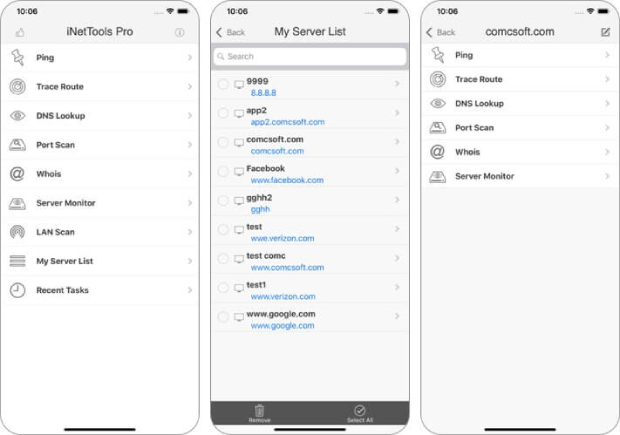
When used as an iPhone WiFi analyzer, iNetTools Pro can tell you which ports are open and potentially exposed to online threats, how long it takes data packets to complete their journey from your router to a remote server, and more.
-
Includes many network diagnostic tools
-
IPv4 and IPv6 support
-
Quick access to frequently used servers
-
Offers unlimited technical support via email
-
Geared towards advanced users
Network Analyzer is one of the more approachable WiFi analyzer apps on this list. The app has been designed to help iPhone users troubleshoot various networking problems, such as poor signal strength, connection drops, or high latency. Network Analyzer includes a capable WiFi scanner that can quickly and reliably detect all nearby network devices.
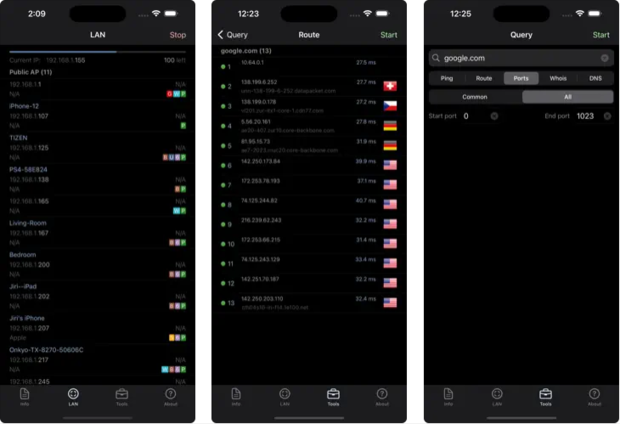
The application serves a slightly different purpose than NetSpot or Ubiquiti WiFiMan, focusing mainly on detecting issues on remote servers, revealing all LAN device addresses and names, performing DNS lookups — this sort of stuff. As such, it complements these other tools by providing a more in-depth look into the network's infrastructure.
-
Wide range of network diagnostic tools
-
Capable of detecting issues on remote servers
-
Regularly updated
-
Full support of IPv6
-
Intended for more advanced network troubleshooting
Fing is one of the most popular WiFi analyzers in the App Store. It shines the most when used together with Fingbox, a plug-and-play device designed to give you more control over your home network. With it, Fing can be used to block intruders and unknown devices, set parental control features, analyze bandwidth usage, and receive alerts when your family members come home.
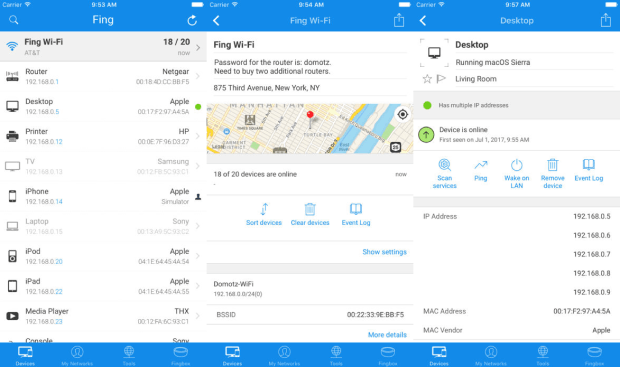
Without Fingbox, this iOS WiFi analyzer is still more than capable enough to provide you with plenty of useful information to help you understand wireless activity in your area. For example, you can discover devices connected to nearby networks, run internet speed tests, receive network security and device alerts, and more. Fing is free with in-app purchases, so there’s nothing stopping you from giving it a try.
-
Discovers all connected devices
-
Offers alerts for network security issues
-
WiFi and cellular internet speed tests
-
Enhanced functionality with Fingbox
-
Reliance on Fingbox for full functionality
Opensignal Internet Speed Test is a completely free WiFi analyzer app for iPhone and iPod touch that also lets you test the speed of your 3G, 4G/LTE, or 5G connection. Testing with this analyzer app takes just 20 seconds (10 seconds for the download test and 10 seconds for the upload test), and test results are automatically saved so they can be turned into useful network statistics with average speeds for download, upload, and latency.
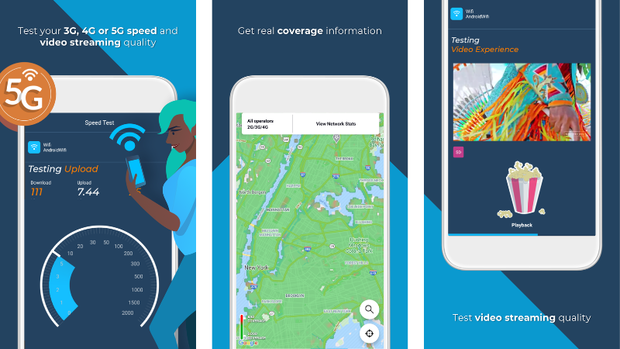
OpenSignal Internet Speed test aggregates data from its users and transforms it into coverage maps that show signal strength down to street level. You can use these coverage maps to determine ahead of time how fast you can expect your mobile internet to be when traveling across the country to know whether or not you should download a few movies to your device ahead of time.
-
Detailed speed tests for 3G, 4G/LTE, 5G, and WiFi connections
-
Saves test results automatically
-
Street-level coverage maps
-
Completely free to use without any ads
-
Concentrates on speed testing
Scany presents itself as the Swiss army knife of network scanning. Its green-on-black color scheme purposefully evokes hackers and movies like The Matrix, as if to tell new users that it means business. It includes a wide set of network analysis tools, such as ping, trace, WHOIS, DNS lookup, port scanner, and others, all designed to provide more or less the same functionality as their desktop counterparts.
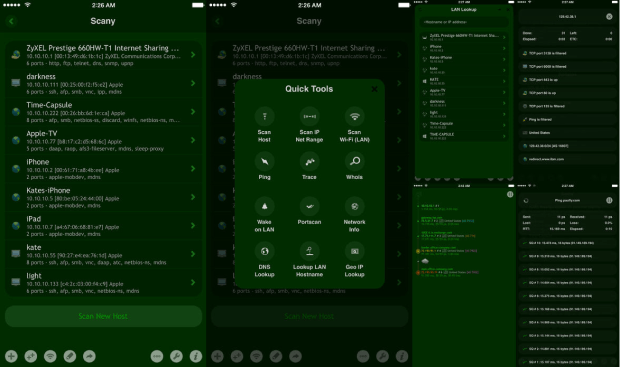
While Scany is packed with advanced features, it's important to note that it's intended for a more specialized audience. Its extensive set of tools is particularly beneficial for those with specific network analysis needs, such as IT professionals, network administrators, or tech enthusiasts. However, for home users looking to simply enhance their WiFi performance, Scany might offer more capabilities than necessary.
-
Versatile network analysis toolset
-
Real-time network path traceroute monitoring
-
Includes a fast port scanner
-
Options for data export and import
-
Potentially off-putting hacker-like interface
-
Not suitable for regular home users
Speedtest by Ookla is widely recognized as the best WiFi analyzer app for iPhone when it comes to internet speed testing. Thanks to its global network of more than 12,000 testing servers, the app provides highly accurate and locationally relevant results that reflect the true performance of your internet connection.
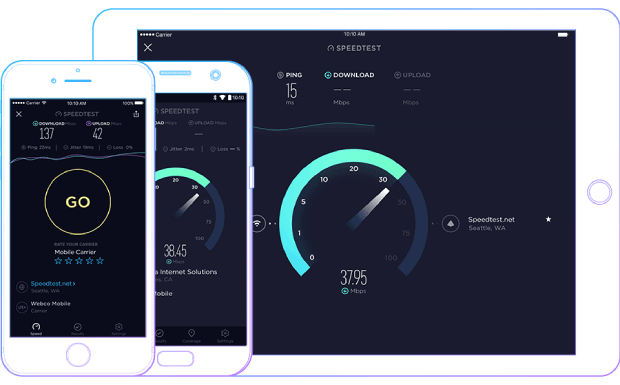
Unlike many other similar WiFi analyzers for iPhone, Speedtest by Ookla includes a dedicated video testing feature that lets you perform a real-time assessment of your network’s current streaming quality. The app is supported by ads, but you can remove them for a one-time fee of just $0.99. There’s also an option that lets you subscribe to Ookla’s VPN service for $4.99, but we haven’t tested it.
-
Network of over 12,000 servers
-
Simple, one-tap process
-
Comes with an integrated VPN service
-
Supported by ads
-
Focuses on internet speed testing
Wi-Fi SweetSpots is more than just an internet speed test utility. It allows you to observe how your WiFi connection speed fluctuates over time, helping you discover the best place for your router and monitor if your internet service provider is actually delivering the speeds you’re paying for.
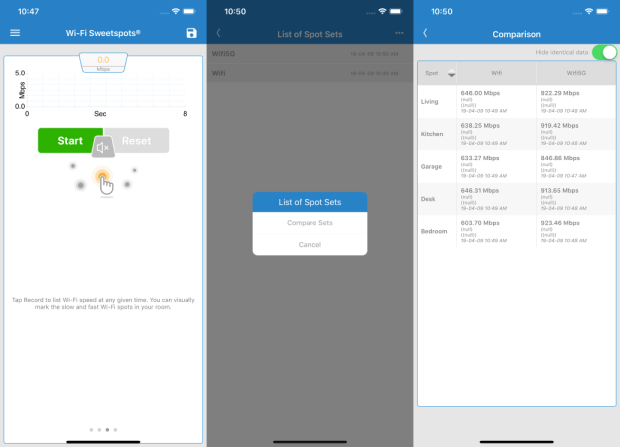
Monitoring WiFi speed with Wi-Fi SweetSpots is a matter of a simple tap, and the app can even virtually mark the slow and fast WiFi spots in your room or compare multiple datasets. Unfortunately, this WiFi analyzer app can't collect wireless network coverage information, so it might be difficult to determine the real cause of your WiFi issues.
-
Straightforward speed monitoring tool
-
Simple and easy-to-use design
-
Rated well on the App Store
-
Speed monitoring only
-
Hasn't been updated for a while
If you’ve ever wondered if someone’s piggybacking on your network without you knowing about it, WiFi Analyzer by Master App Solution can give you a clear answer. This capable WiFi network analyzer can perform a detailed analysis of your home network and give you insight into its performance and configuration.
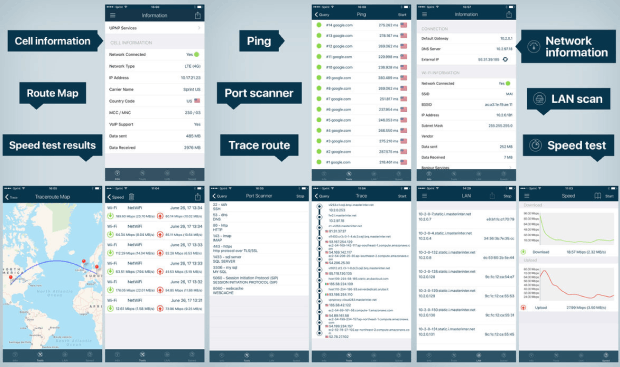
You can also use it to learn more about nearby WiFi networks with tools such as ping or whois. All tools included in the app are available for a single payment. But before you hit the Buy button, you should consider that WiFi Analyzer hasn't been updated since 2018. That's a very long time, so the app might stop working with the next iOS update.
-
Robust set of WiFi analysis features
-
Measures internet speed with just one tap
-
Hasn't been updated for a very long time
-
Outdated user interface
How to Analyze Wi-Fi Coverage with NetSpot
One reason why we selected NetSpot as the best WiFi analyzer app for iOS was its exceptional ease of use. You don’t need any special skills or knowledge to analyze WiFi coverage with NetSpot — all you need is your iPhone.
Install and launch NetSpot for iOS
To begin using NetSpot, the WiFi app for iPhone, download and install the app from the App Store. It’s freely available and supports multiple languages. Once the app is installed, launch it to start your first WiFi analysis.
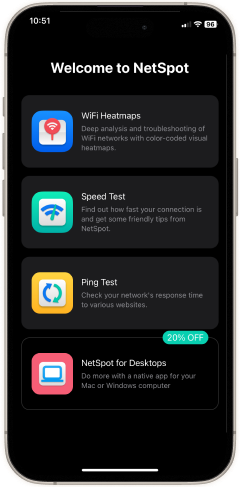
Create a New Project
Open NetSpot and initiate a new project. The WiFi app for iPhone gives you the flexibility to use an existing map from your photo library or to take a photo of a physical map. This map will serve as the foundation for your WiFi analysis.
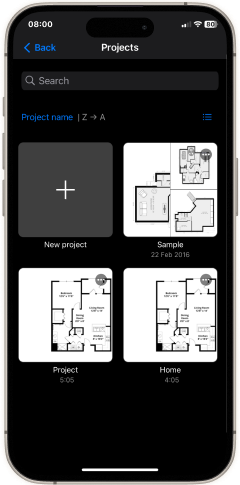
Calibrate Your Map
Accurate map calibration is essential for precise measurements. Calibrate your map by marking the distance between two known points. The more precise the distance is, the more reliable analysis of your WiFi coverage you can expect.
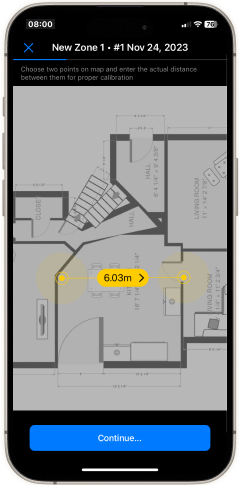
Collect WiFi Data
Start collecting WiFi data by placing your iPhone at various points on the map, ideally starting in a corner and moving evenly across the area until you achieve comprehensive coverage of the surveyed area. When a data point is captured by the app, you will see a blue circle and hear a sound.
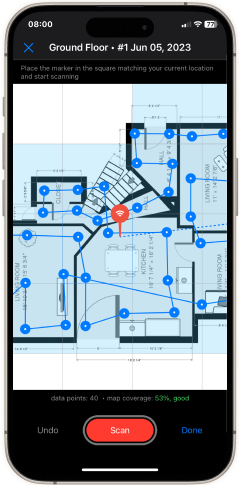
Analyze the Results
After collecting a sufficient number of data points, it’s time to analyze the results, which are presented in the form of an easy-to-understand WiFi heatmap. Look for areas that exhibit weak signals or significant channel overlaps. Based on these findings, you might consider adjusting your router’s settings or its placement to improve your WiFi coverage.
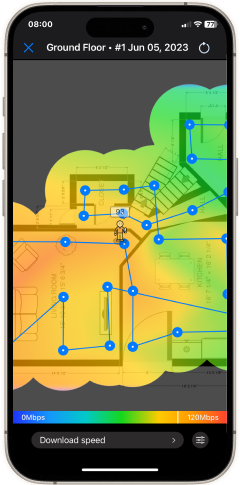
NetSpot on Desktop: Perform an in-depth analysis of your WiFi network
NetSpot for iOS and other best WiFi analyzer iOS apps are convenient and useful, but they’re not nearly as comprehensive as their desktop counterparts. With the desktop version of NetSpot (available for Windows and macOS), you can learn a wealth of useful information about your own WiFi network and other networks in your area.
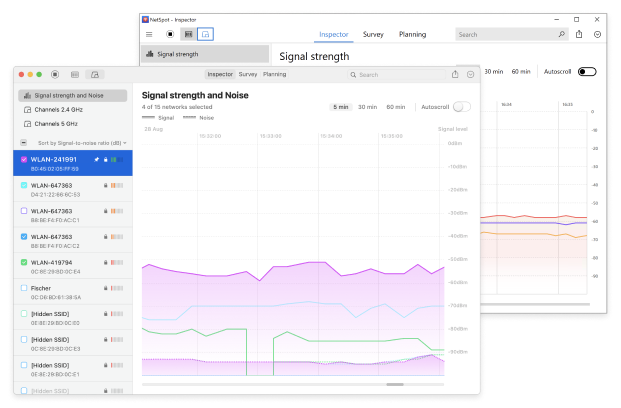
More specifically, you can create detailed heatmaps that overlay gathered information on a map in an intuitive, color-coded manner, making it easy to spot areas of signal weakness, sources of signal interference, and other problems.
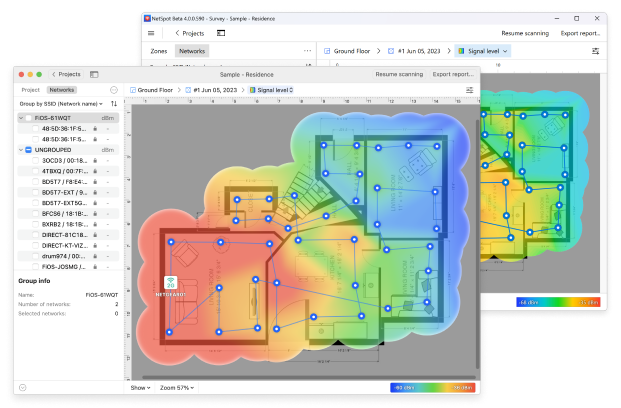
Conclusion
There’s no reason to fear WiFi analysis. With the right WiFi analyzer for iPhone, anyone can learn more about their WiFi network and improve its performance. NetSpot is our favorite WiFi analyzer for iOS because it combines ease of use with capable features, satisfying the requirements of professionals and home users alike.
Best WiFi Analyzer for iPhone — FAQs
The best WiFi analyzer for iPhone is NetSpot. Rated highly on the Apple App Store, it offers intuitive heatmap visualizations to identify strong and weak signal areas. Additionally, NetSpot includes a WiFi speed test function, allowing users to monitor and track wireless network performance. This app does not require any additional hardware.
To check WiFi signal strength on your iPhone, you can simply look at the WiFi indicator icon in the status bar at the top of your screen; more bars indicate a stronger signal. Alternatively, for a more detailed analysis, you can download a WiFi analytics software like NetSpot from the App Store.
To use your iPhone as a WiFi scanner with NetSpot:
- Install NetSpot wifi app for iPhone from the App Store.
- Launch NetSpot and start a new project, using either a map from your photo library or a photo of a physical map.
- Calibrate your map for accurate measurements.
- Collect WiFi data by placing your iPhone at various points on the map.
- Analyze the results through the app's heatmap visualization to determine areas with strong or weak WiFi signals.
Using NetSpot as a WiFi scanner is easy, and the accuracy of the obtained results is good enough even for professionals, making it the best WiFi analyzer app for iOS.
Here’s what you need to do to run a WiFi diagnostic on your iPhone:
- Launch the Settings app.
- Go to the WiFi section.
- Tap the small “i” button next to the wireless network you would like to diagnose.
Your iPhone can tell you the network’s BSSID, channel, signal strength, security settings, and more. If you’d like even more information about available WiFi networks, then you can download a third-party WiFi analyzer for iPhone, such as one of those described in this article.
Yes, you can use your iPhone as a WiFi repeater, but only if your device is jailbroken, using tethering software called PDAnet. With this handy app, you can turn your iPhone into a true WiFi hotspot so that you can share your mobile internet access with your computer or iPad.
To scan for WiFi channels on your iPhone, use Apple's AirPort Utility:
- Download the AirPort Utility from the App Store.
- Open the Settings app, scroll to AirPort Utility, and enable the WiFi scanner.
- Open the AirPort Utility app, tap on WiFi Scan, then tap Scan.
- Wait for the app to gather information about nearby networks.
- Tap Stop to finish scanning and analyze the results.
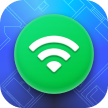
Study your WiFi network, get the real-time data and analyze it on the spot.
You'll need iOS 15.5 or newer
